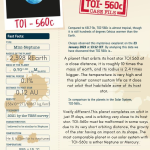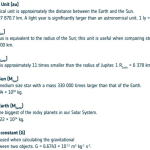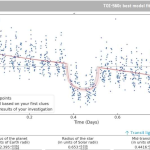
Project Gallery 2023
Secondary students from across Europe became exoplanet detectives with ESA and used Cheops satellite data to uncover the mysteries of two exoplanet targets: KELT-3b and TOI-560c.
Explore the projects below.
O-Moon
Liceul Teoretic “Emil Racovita” Baia Mare – Maramures Romania 16 years old 2 / 1
TOI-560c
TOI-560c project description:
Our goal was to further analyse the planet TOI-560c, discover its orbital period, the distance between it and its host star, its density and composition, and probably the most important factor when discovering any new planet; its habitability, or its ability to sustain living organisms.
TOI-560c Results and Analysis
Step 1
The first step was to access its data, which we did using allesfitter.
Step 2
The second step was to find its transit depth, and its size. The transit depth can be directly measured on the graph above. It is somewhere around 0.1%. Its size was determined using the following formula:
𝑅𝑝 = √𝑅𝑠2𝑥𝑡𝑟𝑎𝑛𝑠𝑖𝑡𝑑𝑒𝑝𝑡ℎ 100
Where Rp is the radius of the planet;
Rs is the radius of the host star;
In our case, the radius of the star is known and providedin the case file:
Rs=0.65 RSun
𝑅𝑝 = √0.65𝑥0.1 100 = 0,022
We then converted the result to earth radii units by multiplying the result with 109 (this is because the radius of the sun is 109 bigger than the radius of the earth)
Rp=0,022 x 109 = 2,398
Step 3
On the third step, we had to find the orbital period and the distance between the planet and its host star
The orbital period was known and again provided in the case file.
T=18.8797 days, converted in seconds, it’s about 1631206.08 seconds
The distance was calculated using the following formula:𝑑 = √𝐺𝑀𝑠 4𝜋2 3 × 𝑇 2
G- gravitational constant
Ms- mass of the star
T= orbital period
We complete the equation with what we already know, giving us the following :
𝑑 = √6.67430𝑥10−11𝑚3𝑘𝑔−1𝑠 −1 × 1,45 × 1030 4𝜋2 3× 16312062
After converting into A.U (astronomical units) the result should be around 0.12 A.U
This number is comparable to mercury, which orbits 0.4 A.U from the sun
Step 4
On step 4 we had to determine the temperature and habitability of the planet TOI-560c. Of course, this planets temperature is way too high to sustain life (or at least life as we know it)
TOI-560c has a temperature of 225 celsius
Step 5
The last step was to find out its composition and volume
𝑞 = M/V
Volume can be calculated, assuming that it is a perfect sphere
𝑉 =4/3× 𝜋 × 𝑅^3
𝑉 = 61867 𝑘𝑚3
Lastly, the density which is 𝑞 =58×1027𝐾𝑔/61867 𝐾𝑚
TOI-560c Conclusions
TOI-560c is a neptune-sized planet that orbits very close to its host star. Its composition is mostly made up of Helium and Hydrogen, it is a gaseous planet OR if it is as similar to Neptune as we think it is, its composition could consist of water, ammonia and methane. This planet is not habitable, as it is far too hot for it to sustain life.
Supporting files:





